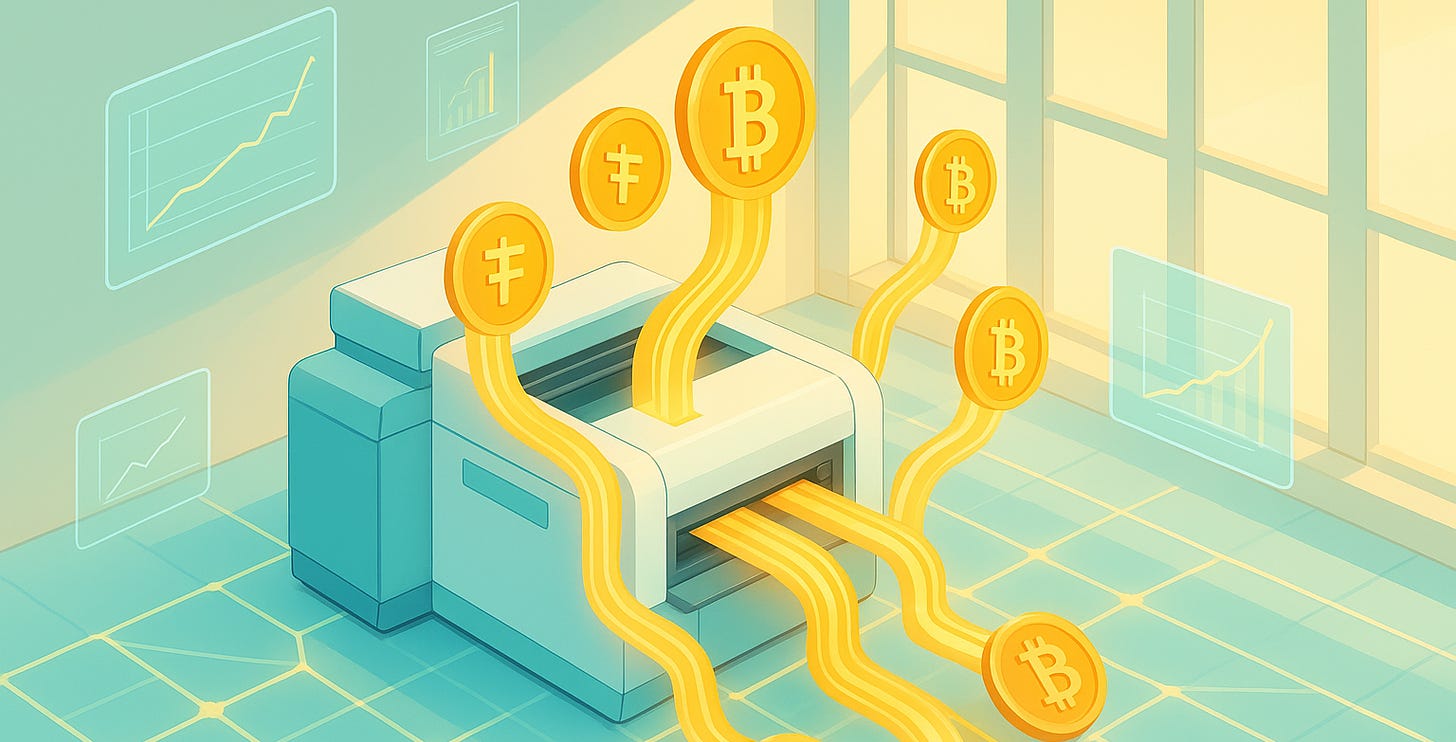The Tether fraud allegations
A comprehensive investigation
This is a comprehensive research into Tether. I was inspired by a series of tweets that Tether was again and again minting billions of coins. It is such a large player in the crypto markets that if anything in this research is even remotely true, would collapse the whole house of crypto-cards in a flash.
The allegations are mostly proven correct for the ‘17-’18 period, but if they show anything is that Tether is a company build on fraud. Which I truly hope I'm wrong about, but I know people don't change so easily.
Tether (USDT), now a $120+ billion stablecoin claiming 1:1 dollar backing, has been definitively proven to have operated without full reserves for the majority of a 26-month period during crypto’s explosive 2017-2018 growth. Federal regulators confirmed the company was only properly backed 27.6% of the time during this critical period, while academic research published in the Journal of Finance suggests at least half of Bitcoin’s historic rise to $20,000 may have resulted from coordinated price manipulation using unbacked Tether tokens. Despite $61 million in combined regulatory fines and admissions that it was only 74% backed when confronted, Tether has never completed the independent audit it has promised since 2015, operates through offshore entities with a history of falsified banking documents, and federal prosecutors are currently investigating whether the company violated money laundering and sanctions laws.
This matters because Tether underpins roughly half of all Bitcoin trading globally. If the allegations of systematic fraud are accurate, tens of billions in cryptocurrency “value” may have been conjured through what critics call an “infinite money glitch”—printing unbacked tokens to artificially inflate prices. The company’s ongoing opacity, documented connections to drug cartels and Russian sanctions evasion, and pattern of deception revealed through court documents suggests the fraud may be ongoing at an unprecedented scale.
BitFinexed’s prescient investigation revealed a pattern that regulators later confirmed
An anonymous researcher known as BitFinexed began investigating Tether and its sister exchange Bitfinex in April 2017, years before regulatory action vindicated the core allegations. BitFinexed documented that between June 1 and September 15, 2017, Bitfinex had only two customers deposit USD—and neither purchased any Tether—yet hundreds of millions of dollars worth of tokens were issued during this period.
The work faced fierce opposition from crypto enthusiasts who dismissed it as “FUD.” Yet every major prediction came true: The New York Attorney General investigation found that starting in mid-2017, Tether had “no access to banking, anywhere in the world.” The CFTC confirmed in October 2021 that Tether held sufficient reserves only 27.6% of the time from 2016-2018. Court documents revealed Bitfinex had lost over $850 million and secretly used Tether’s reserves as a “corporate slush fund.”
BitFinexed’s blog posts were cited in NYAG court documents, and the researcher was named to CoinDesk’s “Most Influential 2021” list.
Legal proceedings exposed admission that Tether was only 74% backed
The April 2019 lawsuit by New York Attorney General Letitia James represents the most damning official documentation of Tether’s fraud. In a sworn affidavit, Stuart Hoegner—General Counsel for both Tether and Bitfinex—admitted under oath that “Tether has cash and cash equivalents on hand totaling approximately $2.1 billion, representing approximately 74 percent of the current outstanding tethers.”
The settlement agreement revealed systematic deception. On September 15, 2017, Tether finally opened an account at Noble Bank after operating for months without legitimate banking. That same morning, Bitfinex transferred $382 million to the new account. At 8:00 PM that evening, accounting firm Friedman LLP conducted a “verification” of the balance. The NYAG settlement stated: “No one reviewing Tether’s representations would have reasonably understood that the $382,064,782 listed as cash reserves had only been placed in Tether’s account as of the very morning that Friedman verified the bank balance.”
An identical pattern occurred in November 2018. On November 1, Tether announced a partnership with Deltec Bank, linking to a letter showing $1.831 billion in backing. The very next day, Tether began transferring $625 million to Bitfinex to cover the exchange’s losses. The settlement finding was unequivocal: “As of November 2, 2018, tethers were again no longer backed 1-to-1 by U.S. dollars.”
The case also revealed that from June to September 2017, only approximately $61 million backed 442 million tokens—roughly 14% backing in actual cash.
Academic research traced half of Bitcoin’s 2017 surge to systematic manipulation
University of Texas finance professor John Griffin and Ohio State professor Amin Shams published “Is Bitcoin Really Untethered?” in the Journal of Finance after analyzing over 200 gigabytes of blockchain data. Their findings: purchases with Tether were “timed following market downturns” and “flow was attributable to one entity,” with patterns “most consistent with the supply-based hypothesis of unbacked digital money inflating cryptocurrency prices.”
The researchers identified specific wallet addresses controlled by a single large player operating across exchanges. Just 95 one-hour periods—representing 1% of trading hours—accounted for approximately 60% of Bitcoin’s price gains during the study period.
Griffin and Shams estimated that manipulation could account for approximately 50% of Bitcoin’s rise from around $1,000 to nearly $20,000. A separate 2022 study used agent-based modeling to simulate the period. The model successfully reproduced actual Bitcoin prices only when a “fraudulent agent” was included. Without the fraudulent agent, the probability of Bitcoin reaching $20,000 was “practically zero.”
Counter-research exists. A 2020 study by UC Berkeley’s Richard Lyons found “no systematic evidence of stable coin issuance driving cryptocurrency prices,” though it examined a later period when market dynamics had evolved.
The infinite money glitch: How unbacked token printing allegedly worked
The manipulation mechanism operated in five coordinated phases:
Phase 1: Tether Limited would mint new USDT tokens without corresponding dollar deposits. The CFTC confirmed this occurred systematically during 72.4% of days sampled from 2016-2018.
Phase 2: Newly minted Tether would flow from the Treasury wallet to Bitfinex, then through intermediate addresses, and finally to other exchanges—primarily Poloniex and Bittrex.
Phase 3: Large USDT-to-Bitcoin purchases would activate when Bitcoin prices declined, particularly just below round price thresholds. This triggered cascading effects as other traders interpreted rising prices as bullish sentiment.
Phase 4: Bitcoin acquired using unbacked Tether was essentially free. The manipulator could sell a portion at inflated prices to generate dollars for monthly reserve checks while retaining substantial Bitcoin acquired without capital expenditure.
Phase 5: Tether published “proof of reserves” on the 15th of each month—not coincidentally when Griffin and Shams identified unusual volume spikes.
Tether operated without audits despite being larger than most banks
Tether has never completed an independent audit despite continuous promises since its 2014 founding. Paolo Ardoino, Tether’s CEO, explained in 2024 that the Big Four accounting firms refuse to audit Tether due to “potential reputational risks.”
The timeline of failed audit attempts reveals abandonment at critical moments. In September 2017, Tether engaged accounting firm Friedman LLP, but the relationship dissolved months later. General Counsel Stuart Hoegner admitted in June 2018: “The bottom line is an audit cannot be obtained.”
What Tether provides instead are quarterly “attestations” from BDO Italia, a small Italian accounting firm. An attestation is a snapshot of a single moment with limited scope, fundamentally different from an audit. As former SEC enforcer John Reed Stark stated: “Attestations only evaluate whether the data being examined is accurate at that precise moment in time. Hence, any iteration of attestation is pretty useless.”
In May 2021, Tether released its first detailed breakdown showing only 3.87% held in actual cash. The majority was 65.39% commercial paper, yet Financial Times investigations found major commercial paper traders had never heard of Tether participating in their markets.
By October 2022, Tether claimed it had reduced commercial paper to zero. Current disclosures show $4.46 billion in “Other Investments” with no specification of what these represent.
Historical banking chaos revealed Tether operated without accounts for extended periods
Tether’s banking history resembles a shell game. In March 2017, Wells Fargo stopped processing transactions. From mid-2017 to September 15, 2017, the NYAG investigation confirmed Tether had “no access to banking, anywhere in the world.”
Approximately $60 million was held in General Counsel Stuart Hoegner’s personal account at Bank of Montreal—not a corporate account. The CFTC found that during this period, only $61.5 million in total funds existed while 442 million tokens were in circulation—approximately 14% backing.
Unable to access legitimate banking, Tether turned to Crypto Capital Corp., an unregistered Panamanian payment processor. Over $1 billion was transferred to this entity, with which Tether never signed any written contract. By late 2018, approximately $850 million held by Crypto Capital was seized by governments or disappeared.
Wall Street Journal reporting in March 2023 revealed that Tether used falsified documents to open bank accounts in Taiwan. Accounts were opened under different corporate names than the actual operating entities.
Documented evidence proves Tether-Bitfinex conflict of interest enabled reserve raiding
The Paradise Papers leak in November 2017 revealed both Tether and Bitfinex are subsidiaries of iFinex Inc., a British Virgin Islands entity. The same executives controlled both companies: Jan Ludovicus van der Velde as CEO of both, Giancarlo Devasini as CFO of both.
This common ownership created fundamental conflicts of interest. When Bitfinex faced a liquidity crisis, the exchange simply took money from Tether’s reserves—reserves that were supposed to back customer tokens 1:1. Tether transferred $625 million from its reserves to Bitfinex and extended a $600-700 million line of credit.
The CFTC found that Tether “commingled reserve funds with Bitfinex’s operational and customer funds,” creating a fractional reserve system.
Alternative media documented patterns ignored by industry press
Bloomberg’s October 2021 investigation “Crypto Mystery: Where’s the $69 Billion Backing the Stablecoin Tether?” revealed that Treasury Secretary Janet Yellen convened an emergency meeting to discuss whether Tether posed a systemic threat.
The New Republic published a comprehensive January 2021 investigation warning that Tether involves “strange criminal characters, unsolved hacks, sudden switches between overseas banks, and huge, unexplained losses.”
The Paradise Papers revelations showed how systematically the Tether-Bitfinex ownership structure had been concealed, coming in November 2017 at the height of Bitcoin’s bubble.
Podcast investigators Bennett Tomlin and Cas Piancey have produced extensive analysis through “Crypto Critics’ Corner,” documenting Tether’s history with forensic detail.
Summary
Three regulatory bodies have confirmed core elements: The CFTC found Tether was only properly backed 27.6% of the time and paid $41 million in fines. The New York Attorney General obtained admission that Tether was only 74% backed and extracted an $18.5 million settlement. The Department of Justice investigation, while not yet resulting in charges, has been ongoing since 2018.
Academic research published in top journals traced approximately half of Bitcoin’s 2017 price appreciation to manipulation using Tether. The timing patterns and statistical significance cannot be explained by legitimate activity.
Yet remarkably, Tether has grown to over $120 billion in circulation—making it larger than most U.S. banks. Professor Griffin noted that after the FTX collapse in November 2022, Bitcoin showed “very suspicious” stability, suggesting “the same mechanism we saw in 2017 could be at play now.”
The central fraud allegation—that Tether prints unbacked tokens to manipulate crypto prices—has been substantially proven for the 2017-2018 period through the convergence of regulatory findings, academic research, court admissions, and investigative journalism.
Whether it continues today remains unprovable without the audit Tether refuses to complete, but the company’s pattern of deception and resistance to transparency suggest the fraud never ended—it merely grew too large to challenge.
What would happen if there is fraud, and it gets exposed?
If Tether’s fraud continues at current scale but remains hidden beneath layers of increased market liquidity and more sophisticated obfuscation, the eventual exposure could trigger the largest financial collapse in cryptocurrency history—dwarfing the $32 billion FTX failure by an order of magnitude.
Why the fraud might be harder to detect now
The 2017-2018 manipulation worked in a relatively illiquid market where $100 million in coordinated purchases could move Bitcoin’s price by thousands of dollars. Today’s crypto market has roughly 10x the daily trading volume, meaning the same manipulation techniques would produce proportionally smaller visible effects. A manipulator could print $1 billion in unbacked Tether and the resulting price impact might appear as normal market volatility rather than the suspicious price spikes that academic researchers identified in 2017.
Additionally, the crypto ecosystem now includes institutional participants, ETF inflows, corporate treasury holdings, and retail investors who genuinely believe in cryptocurrency’s value proposition. These participants provide “cover” for manipulation—their legitimate buying and selling activity masks the patterns that would otherwise reveal coordinated pump schemes. When Bitcoin’s price rises, it’s now plausible to attribute it to institutional adoption, regulatory clarity, or macroeconomic factors rather than immediately suspecting manipulation.
Tether has also learned from past mistakes. The company now publishes quarterly attestations (however inadequate), maintains relationships with larger exchanges, holds a more diversified reserve composition on paper, and has increased its public relations efforts. The veneer of legitimacy is thicker even as the core transparency problems remain unchanged.
The mechanics of a Tether collapse
A Tether collapse would likely begin with a triggering event that breaks market confidence. This could be a DOJ indictment of Tether executives, a major regulatory action forcing exchanges to delist USDT, leaked internal documents proving reserves don’t exist, or a large holder attempting to redeem billions and being unable to receive actual dollars. The initial trigger matters less than the cascade it initiates.
Once confidence breaks, the mechanism becomes self-reinforcing. Tether holders rush to exchanges to convert USDT to Bitcoin, Ethereum, or other cryptocurrencies before the token becomes worthless. This sudden selling pressure crashes the dollar-pegged value of Tether below $1.00—perhaps to $0.95, then $0.90, then $0.80 as panic accelerates. Arbitrageurs who normally profit from small deviations from the peg discover they cannot redeem Tether for actual dollars at Tether Limited, destroying the fundamental mechanism that maintains the $1.00 value.
Simultaneously, anyone holding Bitcoin or other cryptocurrencies purchased with Tether-derived liquidity attempts to exit to actual fiat currency. The problem: roughly half of all Bitcoin trading volume uses Tether as the trading pair. When USDT becomes untrusted, this liquidity vanishes overnight. Bitcoin holders cannot sell for USDT because USDT is collapsing; they must sell for actual fiat currency through the limited number of exchanges offering true USD pairs. The mismatch between selling pressure and available fiat liquidity would be catastrophic.
Estimated price impact across cryptocurrencies
Bitcoin’s price could realistically fall 60-80% within days of a confirmed Tether collapse, potentially dropping from current levels around $120,000 to $20,000-40,000. This isn’t speculation—it’s based on previously mentioned academic research that showed that approximately 50% of Bitcoin’s historic rise was attributed to Tether manipulation. If that artificial support is removed and combined with panic selling, the price would likely overshoot downward before finding a new equilibrium.
The impact would be more severe for altcoins. Ethereum might drop 70-85%, as its market is even more dependent on Tether trading pairs and has less institutional adoption to provide a floor. Smaller cryptocurrencies trading primarily against USDT could see 90-95% collapses, with many effectively going to zero as liquidity completely evaporates.
The total cryptocurrency market capitalization, currently around $3.5 trillion, could contract to $800 billion to $1.2 trillion—a loss of $2-2.7 trillion in paper wealth. For context, this would be roughly equivalent to the 2008 U.S. housing market collapse in absolute dollar terms, though concentrated in a much smaller investor base.
Exchange failures and contagion effects
Cryptocurrency exchanges would face an existential crisis. Many exchanges hold substantial Tether reserves as part of their operational liquidity—these reserves would suddenly be revealed as partially or completely worthless. Binance, the world’s largest exchange, has historically held billions in USDT. A Tether collapse could render the exchange insolvent overnight if those reserves cannot be converted to actual assets.
Smaller exchanges would likely fail within days. Without access to deep fiat liquidity or large capital reserves to absorb losses, they would halt withdrawals, freeze customer accounts, and eventually declare bankruptcy. Even larger exchanges might implement withdrawal limits or temporary freezes—the exact scenario that crypto proponents claim the technology prevents.
The contagion would spread to other stablecoins. USDC (Circle), BUSD (Binance), and others would face redemption runs as investors fear similar fraud. Even if these stablecoins are legitimately backed, the sudden redemption pressure could force them to liquidate reserves at unfavorable prices, creating temporary depegging that reinforces panic. The entire stablecoin sector—currently about $200 billion—could contract by 50-70% as trust evaporates.
DeFi protocols would experience cascading liquidations. Many decentralized finance platforms use Tether as collateral or liquidity provision. When USDT’s value collapses, loans become undercollateralized automatically, triggering liquidation cascades. Protocols like Aave, Compound, and Curve could see billions in bad debt accumulate as collateral becomes worthless faster than liquidation mechanisms can process. Some protocols might become permanently insolvent.
Broader financial system implications
The regulatory response would be swift and severe. The SEC, CFTC, and Treasury Department would likely implement emergency measures including mandatory audits for all stablecoin issuers, immediate delisting of non-compliant tokens, capital requirements for exchanges similar to traditional broker-dealers, and potential criminal prosecutions of exchanges that knowingly facilitated fraud. Congressional hearings would be inevitable, likely resulting in comprehensive crypto regulation that the industry has long resisted.
International coordination would follow. If Tether’s fraud facilitated $19.3 billion in illicit transactions and Russian sanctions evasion, the geopolitical implications would force coordinated action. The EU, UK, and other jurisdictions would likely implement similar crackdowns, potentially banning cryptocurrency trading temporarily while new regulatory frameworks are established.
Traditional financial institutions with crypto exposure would face losses but probably not existential threats. Banks like JPMorgan, Goldman Sachs, and others have limited direct crypto exposure relative to their total assets. However, Bitcoin ETFs approved in 2024 hold tens of billions in Bitcoin purchased by retail investors through traditional brokerages. These investors would see dramatic losses, potentially triggering lawsuits against the ETF sponsors and brokerages for inadequate disclosure of Tether-related systemic risks.
The broader stock market would likely see a brief shock—perhaps a 3-5% drop over several days—as the collapse demonstrates crypto’s fragility and raises questions about other speculative bubbles. However, unlike 2008 when housing was central to the financial system, crypto remains peripheral. Most economic activity occurs without touching cryptocurrency, meaning the real economy impact would be contained.
Who bears the losses
The distribution of losses would be deeply unequal and troubling. Retail investors who purchased Bitcoin, Ethereum, or other cryptocurrencies believing they were participating in a legitimate market would lose the majority of their investments.
Institutional investors would lose substantial sums but most have diversified portfolios where crypto represents less than 5% of total holdings. The pain would be manageable. Hedge funds and family offices that concentrated heavily in crypto could face fund closures and investor redemptions.
The true winners would be the Tether insiders and early manipulators who extracted billions in real dollars during the years of fraud. They acquired Bitcoin essentially for free using unbacked Tether, sold portions at inflated prices, and pocketed genuine fiat currency. Unless criminal prosecutions successfully claw back assets (a lengthy and uncertain process), these individuals would escape with generational wealth built on fraud.
Developing market participants would be devastated. Many in countries with unstable currencies turned to Tether as a dollar proxy for savings and transactions. A collapse would wipe out these holdings with no recourse, as victims in El Salvador, Nigeria, and other markets would have no legal standing to pursue U.S.-based recovery.
Long-term implications for cryptocurrency
The philosophical damage to cryptocurrency might exceed the financial damage. Bitcoin was proposed as trustless, decentralized money that didn’t require faith in institutions. If the asset’s entire price history was manipulated by a centralized company printing unbacked tokens—exactly the scenario Bitcoin was supposed to prevent—the ideological foundation crumbles.
Some argue this would be “healthy” for crypto long-term, eliminating fraud and forcing legitimate projects to prove value. This is overly optimistic. The revelation that crypto’s biggest bull run was substantially fabricated would permanently stigmatize the sector in mainstream perception. Institutional adoption would reverse. Regulatory approval for new crypto products would become nearly impossible. The technology might survive in narrow use cases, but the vision of cryptocurrency as an alternative financial system would be dead.
Alternatively, the ecosystem might prove more resilient than critics expect. After Mt. Gox collapsed in 2014, many predicted Bitcoin’s end—yet the market recovered and grew. After the 2022 collapses of Terra/Luna, Celsius, and FTX, crypto survived. Perhaps a Tether collapse would be viewed as removing a cancer, allowing legitimate projects to rebuild with proper regulatory oversight.
The honest answer is uncertainty. A $120 billion fraud exposure in a $3.5 trillion market operating largely outside traditional financial system safeguards would be unprecedented. The closest historical analogy might be the 1720 South Sea Bubble or the 1637 Tulip Mania—speculative manias that collapsed when their fundamental worthlessness was revealed. Those markets never recovered because the underlying assets had no intrinsic value. Whether cryptocurrency has sufficient intrinsic value to survive would finally be tested definitively.
The case for continued operation despite fraud
Paradoxically, the very scale of Tether’s fraud may ensure its continued operation. At $120 billion, Tether has become “too big to fail” from the perspective of the crypto industry. Exchanges, trading firms, institutional investors, and protocols all depend on USDT liquidity. A Tether collapse would destroy their businesses. This creates perverse incentives for all market participants to maintain the illusion of legitimacy, avoid asking difficult questions, and pray the scheme continues indefinitely.
Regulatory agencies face similar incentives. If the DOJ or SEC conclusively proves Tether is fraudulent and forces its dissolution, they trigger the collapse described above—and receive blame for destroying trillions in paper wealth. It may be politically safer to extract fines, demand future compliance, and allow the scheme to continue rather than force a reckoning. The 2021 NYAG settlement followed exactly this pattern: admissions of wrongdoing, modest penalties, and permission to continue operating.
This creates the deeply disturbing possibility that everyone with power to stop Tether—regulators, exchanges, institutions—has concluded the fraud must continue because the alternative is worse. If accurate, this suggests Tether could operate indefinitely not despite its fraud being known, but because its fraud is known and the consequences of exposure are too severe to allow.
In this scenario, Tether becomes a permanent fixture of crypto markets, a ticking time bomb that participants treat as normal infrastructure because confronting the reality would destroy them. The fraud continues, new retail investors are recruited to absorb losses, insiders continue extracting real value, and the collapse is perpetually deferred—until an external shock or accumulation of internal contradictions makes continuation impossible.
This is perhaps the most troubling conclusion: that the evidence of fraud is already public, regulators already know, and the scheme continues anyway because dismantling it would reveal that the entire crypto bull market was built on nothing. The real question isn’t what happens if Tether fraud is exposed—it’s what happens when markets must choose between acknowledging the fraud and preserving their collective delusion.







Now that the US president’s family is so invested in crypto, there is no way he would let this thing collapse
I'll invest in tulip bulbs thank you, at least you get a flower at the end of the process.